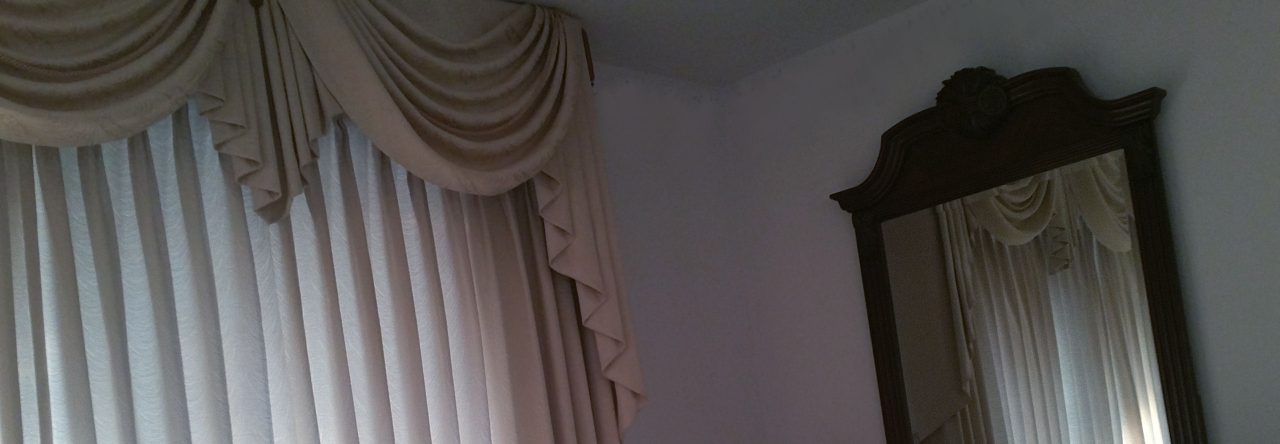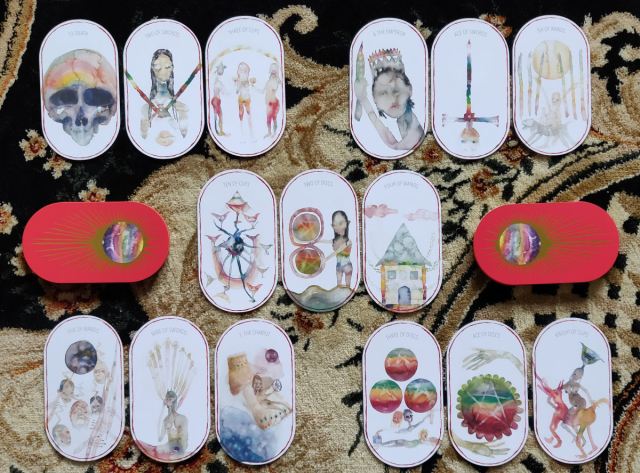The Luminous Void Tarot by Laura Zuspan is a healing deck, one illustrated with watercolor paintings reminiscent of Rorschach inkblot tests, a form of conceptual art interpretation that dates back to Leonardo da Vinci and Sandro Botticelli. Luminous Void is an emotional deck, one that reaches you through the realm of emotion.

Laura Zuspan, the creator of the deck, is a professional tarot reader, mystic, seer, and healer who has taken her practice throughout the San Francisco Bay Area, Los Angeles, and as far as New York City. She also teaches many tarot courses in person in the Oakland area, so be sure to check out her page for all services and course offerings.
The first thing you might notice about Zuspan’s deck is the unique shape: it’s elliptical. Historic playing cards from the late Middle Ages could be found in this unique shape, though over the centuries, the standardized 2.75″ x 4.75″ rectangle for tarot decks has become the norm. Zuspan was inspired to create a deck in the elliptical shape when she saw 15th century playing cards at the Cloisters in New York City.
There’s gold foil accents on the card back design, which is just the most elegant finish to the deck. I love the matte gold gilted edging (the first lead photo in this post shows some of that matte gold finish), and just the level of painstaking detail that Zuspan has devoted to the production of Luminous Void leaves all other deck creators awestruck.
Production-wise, the Luminous Void is printed on 400 gsm cardstock, which is top shelf high-end luxury when it comes to tarot cardstock. These elliptical cards are about 3.4″ x 6.3″, so slightly larger than typical tarot decks, but still easy to shuffle and handle.
I’ve been following Laura Zuspan’s tarot work for some time now, well before the conception of Luminous Void Tarot, and I resonate strongly with her point of view. She focuses her tarot practice on re-framing mainstream culture’s perception of the tarot, blending holistic healing arts with psychology in her readings.
The artwork reminds me of prehistoric cave paintings and the style of the human figures are almost ancient Sumerian in essence. The point of view feels primal, shamanic, and clairaudiently as I work with Luminous Void, I can hear the rhythmic beating of drums.
In Zuspan’s own words, however, she notes that her inspiration for Luminous Void Tarot comes from Tibetan Buddhist concepts of Crazy Wisdom and the Rainbow Body, Trickster Medicine, and mystical Medieval manuscripts, as well as the modern art world. And I totally see that. The result is a wholly contemporary art deck, yet one that pays it homage to tarot history.
When I work with this deck, I get the distinct feeling that I’m consulting the spirit of a medicine man, or witch doctor. That’s how tarot readings with Luminous Void will come across. There’s a discernible difference in intonation here with Luminous Void that I haven’t yet encountered in other tarot decks I’ve worked with. I have no idea how Zuspan managed to tap in to that primordial connection to the underworld and connect us to it through these cards.
I think the suit of Discs (Pentacles) is my favorite in Luminous Void, perhaps because of the color-washed technique Zuspan used to render the discs. Yes, some of the artistic renderings in this deck can feel a bit uneasy to look at, and I think that’s the whole point.
That abstract ghoulishness is why I, just any ordinary tarot reader, can connect into that underworld and journey through what almost feels to me like a prehistoric realm within me, that Origins space I still have unconscious recollections of, which Luminous Void helps to make conscious.
The little white booklet (LWB) features a Golden Dawn Tarot Spread, which I definitely tried out with Luminous Void. Admittedly, at first the featured spread in comparison with the deck’s aesthetic and philosophical point of view felt dissonant. This deck doesn’t have a Golden Dawn vibe, and so I would have figured the tarot spreads featured would go more in the direction of shamanic journeying, primeval healing, tapping in to ancient spirits, that kind of thing. Nonetheless, a fun spread to learn!
What I did with the Golden Dawn spread, though, is instead of reading it in my ordinary classic approach to reading tarot, when pairing the Luminous Void with this particular spread, I sit back, scan the cards, and take in the landscape as a vision board. It’s a vision board created for me by Spirit, to tap in to what I really want deep down. Meditation and pathworking are optimal with Luminous Void.
I think every tarot collector I know at the moment is scrambling to get his or her hands on Luminous Void. It’s definitely one-of-a-kind and fuses history with modernity in such a visually interesting and tantalizing way. It’s the kind of deck only an artist–someone who has an artistic sight of the physical world– who also happens to be a healer and mystic could produce.
Get this deck for your collection, pathwork with it, cast large spreads with the cards to create vision boards you meditate to, and definitely give the Golden Dawn tarot spread a try. Zuspan has created an exceptional deck that reads like a hazy daydream, orphic and prescient.
![]()
FTC Disclosure: In accordance with Title 16 of the U.S. Code of Federal Regulations Part 255, “Guides Concerning Use of Endorsements and Testimonials in Advertising,” I received The Luminous Void Tarot from the deck creator for prospective review. Everything I’ve said here is sincere and accurately reflects my opinion of the deck.














Such a cool deck! Alas, I’ll have to admire it from afar for now. Thanks for sharing the detailed scans of the images, along with your impressions – very helpful. The Death card is definitely my favourite. 🙂
LikeLike
Pingback: Linkage: Magick, monsters, and moonmoons | Spiral Nature Magazine
Pingback: Top 5 Tarot Decks of 2018 – benebell wen
Pingback: The Cantigee Oracle: An Ecological Spiritual Guide to Spark Your Creativity – benebell wen